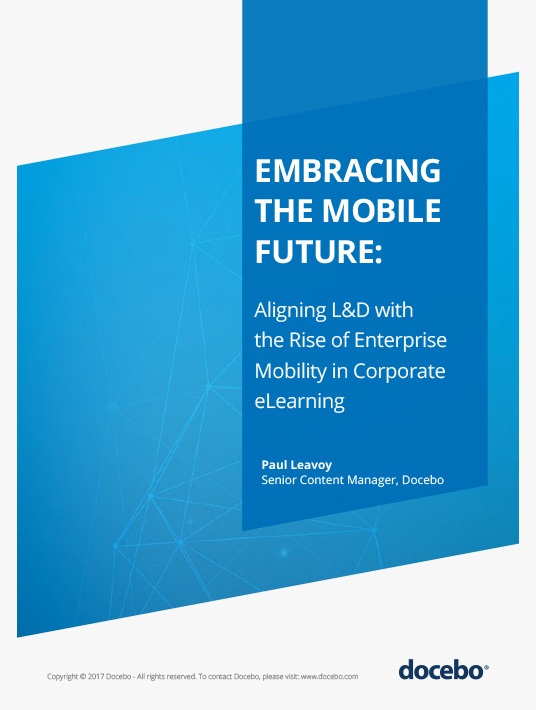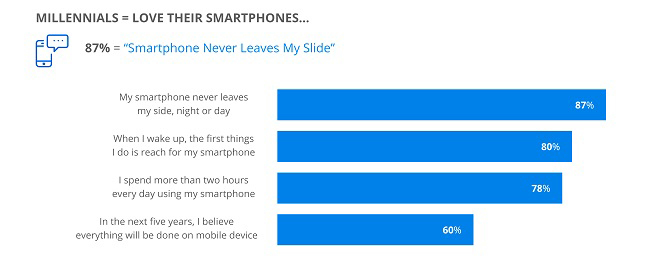Embracing Enterprise Mobility In Corporate eLearning: Learners Are Already Mobile, And That Won’t Change
Smartphones continue to dominate the global market. Almost everyone and their dog (as the saying goes) has a smartphone. Just recently Gartner, Inc. estimated that global sales of smartphones the fourth quarter of 2016 grew 7% over the fourth quarter of 2015, amounting to nearly 1.5 billion units sold throughout 2016.

Although growth in smartphone sales could slightly slow over the next five years according to Business Insider Intelligence estimates, that doesn’t mean people will stop using smartphones. It simply means fewer might purchase smartphones. That could be the result of many factors, including economic impacts, income levels, and the fact users are happy with their existing devices.
Learners Love Their Devices
But what’s currently a key issue is the fact users –in general, but particularly among Millennials– are rarely parted from their smartphones. These devices are always at our sides, and smart L&D leaders have caught on to this and learned to leverage these devices in a way that encourages self-paced, ongoing learning.
Once upon a time Learning and Development leaders viewed learning as mutually exclusive to managing and monitoring devices. In the old model, if employees were on their devices, they were interacting with friends or family, browsing the web, playing games, or watching videos. And, for a while, this might have been true.
Then, all of a sudden, learners had the capacity, through their devices, to accumulate job-related knowledge, onsite, and at the point of need. Things changed. In this sea change –courtesy, in part, to the huge advancements eLearning providers managed to accomplish in delivering LMS portals– learning leaders began to understand that handheld devices could actually be used to help learners learn more efficiently, wherever, whenever, and at the point of need.

Mobility: From Nice-To-Have To A Part Of Doing Business
Mobility in eLearning spent the early 2010s moving from the “nice-to-have” comfort zone to becoming an absolutely essential quality for any company seeking a comprehensive eLearning software vendor worth its weight. In the same way the “cloud-based” offering was an exciting idea in the early 2000s, but is now commonplace among most software vendors, a credible mobile offering is now a must-have for any LMS software vendor under consideration.
Now, nearly half (47%) of organizations use mobile devices as part of their training and eLearning activities, according to Towards Maturity. Also, in 2015, mobile learning was a more than five billion-dollar industry, a number that is expected to exceed $12 billion by the end of 2017, according to Ambient Insight.
Further, the research firm MarketsandMarkets has forecasted that the global mobile learning market will grow from $7.98 billion in 2015 to $37.60 billion by 2020, at a compound annual growth rate (CAGR) of 36.3%. North America is expected to represent the largest market in terms of size, while Europe and Asia-Pacific are expected to experience an increase in market traction during the forecast period.
What’s notable is that Asia is the most vibrant and unique mobile learning market on the planet.
There, mobile learning revenues reached $4.5 billion in 2014 and are expected to increase to $7.7 billion by 2019.

The Inception Of Enterprise Mobility In eLearning
Mobility as a use case became more apparent in other industries before it was realized effectively in eLearning. For example, in Environment, Health, and Safety (EHS), many realized that audits, recordable incidents, and inspections –all of which require checklists– could be executed on the spot with tablets and smartphones whenever EHS incidents and accidents occurred. After all, it was a lot easier to have the information inputted into a system from a device at a point of collection, as opposed to on a piece of paper, which would then be pulled into a spreadsheet, which would then be printed out and put into a binder to collect dust. The paragon of inefficiency.
eLearning took a little longer to jump on the mobility train. But in the last few years –especially with the advent of microlearning– it has become increasingly evident that mobility improves our capacity to get the right information to learners right at the point of need. Also, it helps facilitate what is widely deemed as the most successful mode of approaching L&D in general: The 70:20:10 approach, whereby 70% of knowledge is accumulated through experiential circumstances, 20% is accomplished through social interaction, and 10% resides in the tried and true approach of instructor-led, classroom-based environments. Mobility is assisting the middle component, the 20, enabling learners and experienced folk in the workforce to interact with one another not just at the water cooler, but across social channels as well.
To know more about leveraging mobile learning, download the free eBook Embracing The Mobile Future: Aligning L&D With The Rise Of Enterprise Mobility In Corporate eLearning.









